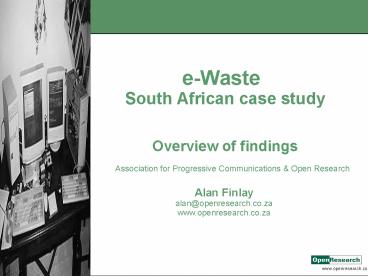eWaste South African case study Overview of findings - PowerPoint PPT Presentation
1 / 9
Title:
eWaste South African case study Overview of findings
Description:
... monitors, cell phones, pagers, microwave ovens, hand-held electronic devices, etc. ... Projected growth of the number of subscribers puts it anywhere ... – PowerPoint PPT presentation
Number of Views:134
Avg rating:3.0/5.0
Title: eWaste South African case study Overview of findings
1
e-Waste South African case study Overview of
findings
Association for Progressive Communications Open
Research
Alan Finlay alan_at_openresearch.co.za www.openresea
rch.co.za
2
What is e-waste?
- Includes computers, televisions, monitors, cell
phones, pagers, microwave ovens, hand-held
electronic devices, etc. - Hazardous materials include lead, cadmium,
mercury, plastics, chromium, mercury
3
Statistics
- Africa is the worlds fastest growing market for
cell phones. 51.8-million. Projected growth of
the number of subscribers puts it anywhere
between 100- and 200-million by the year 2010
(ITU, 2004) - TVs in Africa 62-million radios 200-million
(Jensen, 2003) - Evidence of higher-than-anticipated imports of
old technology into Africa is surfacing.
According to the Basel Action Network, as many as
400-thousand second-hand PCs are imported through
Lagos in Nigeria each month (Warwick, 2005) - 1.2 to 1.5-million computers enter the South
African market each year (Lombard, 2004) - Cell phone users in the country are projected to
be 19-million by 2006
4
Legislation
- Basel Convention
- Absence of legislation dealing specifically with
e-waste - Some disagreement about whether or not this is
necessary, or whether sectors can self-regulate - DEAT now considers e-waste a priority waste
stream
5
e-Waste estimates
- About 70 of the countrys e-waste in storage
- Most of this held by the government
- Represents about 10-20 thousand tons of e-waste
- Expected to double in 10 years time to 30-40
thousand tons
6
Disposal
Differences of opinion on extent of problem of
disposing e-waste on non-hazardous
landfills Some recycling operations result in
storage of hazardous waste because of cost of
disposal Cost of disposal may upset financial
model of current recyclers
7
Export and import
- Some importing of e-waste. Potential
- for this to escalate
- A lot of exporting of raw e-waste with
- Asia and Europe being prime
- destinations
- Universal Recycling says as much of
- 80 of cleaned material is exported
8
Activities
- Basel Convention Regional Centre
- (Pretoria)
- E-Waste Working Group eWASA
- Many ICT multinationals have shown
- little interest in e-waste in South Africa
9
Threats
- Public awareness
- Time
- Buy-in
- Economic model for current recyclers
- Capacity of current recyclers
- Potential threat of small-scale electrochemical
processes being introduced































